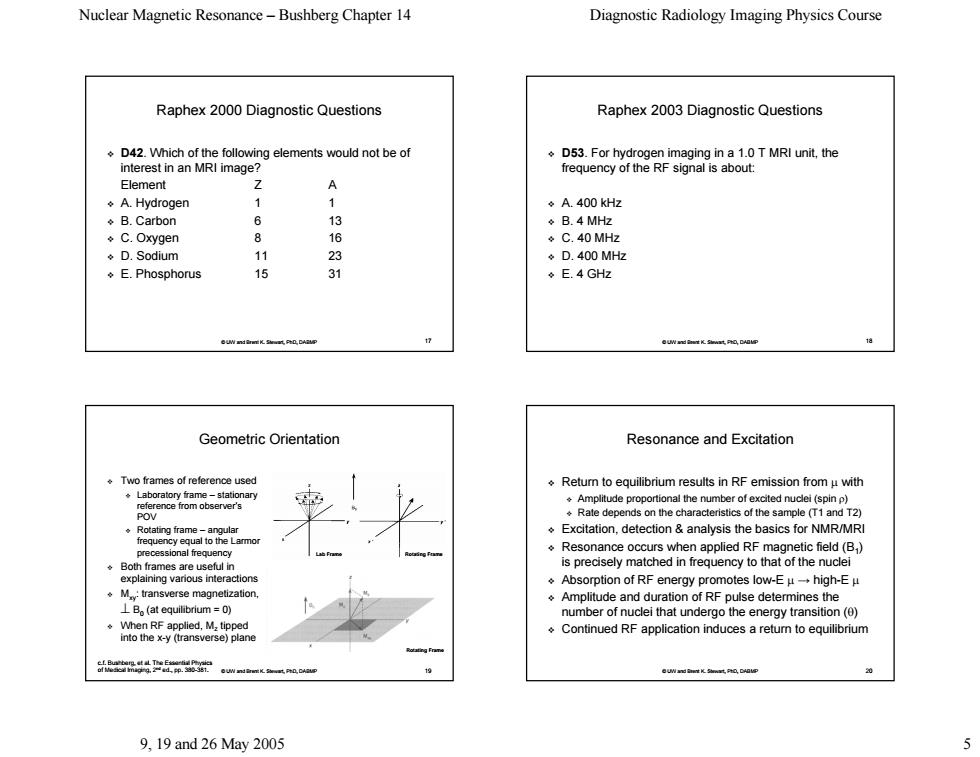正在加载图片...

Nuclear Magnetic Resonance-Bushberg Chapter 14 Diagnostic Radiology Imaging Physics Course Raphex 2000 Diagnostic Questions Raphex 2003 Diagnostic Questions D42.Which of the following elements would not be of D53.For hydrogen imaging in a 1.0 T MRI unit,the interest in an MRI image? frequency of the RF signal is about: Element 2 A ◆A.Hydrogen 1 1 ◆A.400kHz ◆B.Carbon 6 13 ◆B.4MHz ◆C.Oxygen 16 ◆C.40MHz ◆D.Sodium 11 23 ◆D.400MHz ◆E.Phosphorus 15 31 ◆E.4GHz 17 Geometric Orientation Resonance and Excitation Two frames of reference used Return to equilibrium results in RF emission from u with Amplitude proportional the number of excited nuclei(spin p) Rate depends on the characteristics of the sample(T1 and T2) Rotating frame-angular Excitation,detection analysis the basics for NMR/MRI Resonance occurs when applied RF magnetic field(B) is precisely matched in frequency to that of the nuclei explaining various interactions ◆Absorption of RF energy promotes low-Eμ→high-Eμ M:transverse magnetization Amplitude and duration of RF pulse determines the LB.(at equilibrium=0) number of nuclei that undergo the energy transition(0) Whe Continued RF application induces a retum to equilibrium ap UW and Rr 9.19and26May2005 JNuclear Magnetic Resonance – Bushberg Chapter 14 Diagnostic Radiology Imaging Physics Course 9, 19 and 26 May 2005 5 © UW and Brent K. Stewart, PhD, DABMP 17 Raphex 2000 Diagnostic Questions Raphex 2000 Diagnostic Questions D42. Which of the following elements would not be of . Which of the following elements would not be of interest in an MRI image? Element Element Z A A. Hydrogen 1 1 B. Carbon 6 13 C. Oxygen 8 16 D. Sodium 11 23 E. Phosphorus 15 31 © UW and Brent K. Stewart, PhD, DABMP 18 Raphex 2003 Diagnostic Questions Raphex 2003 Diagnostic Questions D53. For hydrogen imaging in a 1.0 T MRI unit, the . For hydrogen imaging in a 1.0 T MRI unit, the frequency of the RF signal is about: frequency of the RF signal is about: A. 400 kHz B. 4 MHz C. 40 MHz D. 400 MHz E. 4 GHz © UW and Brent K. Stewart, PhD, DABMP 19 Geometric Orientation Two frames of reference used Laboratory frame – stationary stationary reference from observer’s reference from observer’s POV Rotating frame – angular angular frequency equal to the Larmor frequency equal to the Larmor precessional frequency Both frames are useful in Both frames are useful in explaining various interactions Mxy: transverse magnetization, : transverse magnetization, ⊥ B0 (at equilibrium = 0) (at equilibrium = 0) When RF applied, Mz tipped into the x-y (transverse) plane c.f. Bushberg, et al. The Essential Physics of Medical Imaging, 2nd ed., pp. 380-381. Rotating Frame Lab Frame Rotating Frame © UW and Brent K. Stewart, PhD, DABMP 20 Resonance and Excitation Return to equilibrium results in RF emission from Return to equilibrium results in RF emission from µ with Amplitude proportional the number of excited nuclei (spin Amplitude proportional the number of excited nuclei (spin ρ) Rate depends on the characteristics of the sample (T1 and T2) Rate depends on the characteristics of the sample (T1 and T2) Excitation, detection & analysis the basics for NMR/MRI Excitation, detection & analysis the basics for NMR/MRI Resonance occurs when applied RF magnetic field (B1) is precisely matched in frequency to that of the nuclei is precisely matched in frequency to that of the nuclei Absorption of RF energy promotes low-E µ → high-E µ Amplitude and duration of RF pulse determines the Amplitude and duration of RF pulse determines the number of nuclei that undergo the energy transition ( number of nuclei that undergo the energy transition (θ) Continued RF application induces a return to equilibrium